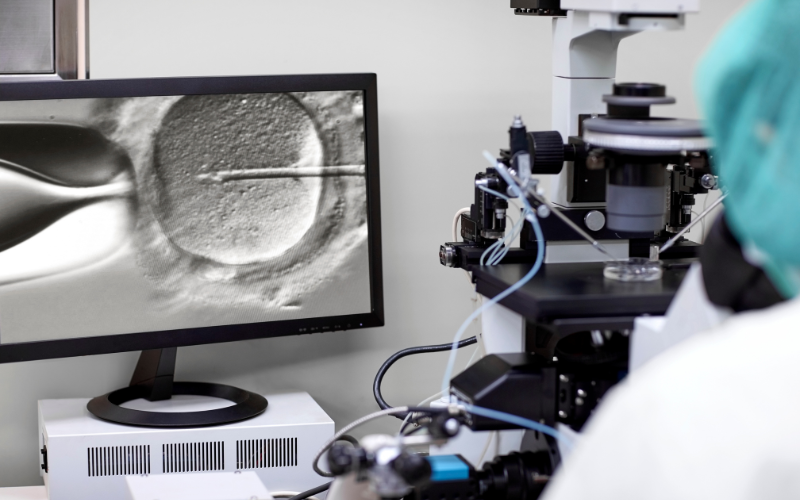If we could create the perfect child, should we? Gene editing is drawing the blueprint for designer babies—but are we correcting nature, or controlling it?
{{ vm.tagsGroup }}
21 May 2025
8 Min Read
Preevena Devi (Contributing Writer)
If we could create the perfect child, should we? Gene editing is drawing the blueprint for designer babies—but are we correcting nature, or controlling it?
We live in a world where editing documents is as easy as clicking the ‘delete’ button. But have you ever thought about the possibility of ‘editing’ your children? Welcome to the era of designer babies!
This concept, once confined to science fiction novels and dystopian cinema, is now inching closer to scientific reality, spurred by rapid advances in genetic technologies like CRISPR-Cas9 and Preimplantation Genetic Diagnosis (PGD). No longer limited to eliminating hereditary diseases, these tools may soon allow parents to influence their children’s physical attributes, intelligence levels, and even personality traits.
But as we begin to explore this new frontier in human reproduction, society is faced with a host of difficult questions: Are we on the brink of curing lifelong illnesses, or are we opening the door to a world of inequality, discrimination, and unintended consequences? Are designer babies a symbol of progress—or a sign that we’re tampering with something we don’t fully understand?
Designer babies are children born from embryos created through in-vitro fertilisation (IVF) that are either selected based on the presence or absence of specific genes or created through genetic interventions that directly edit embryos before implantation, aiming to influence the traits the resulting children will have. In simpler terms, a designer baby is one whose genetic makeup has been selected or edited to achieve specific outcomes, whether to avoid inherited diseases or to enhance physical or cognitive traits.
The term can generally be divided into two categories: therapeutic and enhancement-based. Therapeutic genetic modification involves selecting or editing embryos to prevent serious inherited genetic disorders such as cystic fibrosis, Huntington’s disease, or sickle cell anaemia. Enhancement, on the other hand, refers to altering traits like height, eye colour, athletic ability, or even intelligence—areas where ethical concerns from both the scientific community and the wider public become more pronounced.
Although some level of genetic screening is already common in IVF procedures (such as choosing embryos without known hereditary diseases), the concept of designer babies goes a step further. With emerging tools like CRISPR-Cas9, scientists now have the power to precisely alter genes in embryos, introducing heritable changes that could influence not only the baby but also future generations.
Before discussing its technologies, let’s first explore the process of creating a designer baby. At its core, it follows a straightforward sequence: embryo creation, genetic screening or editing, and finally, implantation. But beneath this seemingly simple outline lies a world of complex science and careful decision-making.
The process begins with IVF, where eggs and sperm are combined in a lab to create embryos. Once these embryos develop, scientists or clinicians can either screen them for specific traits or genetically edit them using advanced biotechnology.
One of the most common and crucial techniques in this stage is PGD. Unlike gene editing, PGD is a screening method—it allows doctors to examine embryos for genetic disorders or chromosomal abnormalities before implantation. This enables parents to select embryos free from inherited diseases like Tay-Sachs disease or thalassemia. PGD is already widely used in fertility clinics worldwide and serves as a stepping stone towards more involved genetic interventions.
Beyond screening comes gene editing. The most well-known tool for this is CRISPR-Cas9—a revolutionary technology that acts like molecular scissors. CRISPR can target specific parts of an embryo’s deoxyribonucleic acid (DNA), cut them, and either disable a gene, repair it, or insert a new sequence altogether. Its unmatched precision has made it the poster child of genetic engineering.
Then there’s germline editing—a form of gene editing that modifies an embryo’s DNA in such a way that it is heritable, meaning the changes can be passed on to future generations. This is where the controversy intensifies. Because germline editing affects not just one child but potentially an entire lineage, many countries have banned or strictly regulated its use. The global scientific community remains deeply divided on whether we are ethically ready to cross that threshold.
While the science and technologies behind designer babies hold the potential for a promising future, they also bring significant challenges spanning science, society, ethics, culture, and commerce.
Unintended mutations are a major concern. Gene editing tools like CRISPR aren’t perfect—they can make off-target cuts or trigger unexpected effects, possibly leading to new diseases instead of preventing them. There’s also the threat of reduced genetic diversity. If everyone started ‘editing’ towards the same ideals—tall, smart, athletic—we risk losing crucial variations that help humans adapt and evolve. Moreover, what seems like a ‘good’ trait may turn out to be harmful in another context. For example, a gene linked to intelligence might also be associated with mental health risks. Our knowledge is still evolving, and tampering with such a delicate system could backfire.
The social implications are even more concerning. Genetic discrimination could become normalised—judging people by the genes they were or weren’t born with. Natural births might be seen as ‘inferior,’ fuelling social divisions eerily reminiscent of eugenics, a dark chapter in history that sought to engineer humanity through selective breeding.
At the heart of the designer baby debate lies a sea of moral dilemmas:
These add yet another layer of complexity. In some societies, genetic intervention may be welcomed as a tool for healing. In others, it may be seen as unnatural or even blasphemous. Then there’s the commercialisation of it all. Private companies race to patent genes, sell embryo screening services, or promise the ‘perfect baby.’ When profit drives science, ethics can be made to take a back seat.

In 2018, the world was rocked by the announcement of He Jiankui, a Chinese scientist who used CRISPR to edit the genes of twin girls in an attempt to make them resistant to Human Immunodeficiency Virus (HIV). It was the first known case of gene-edited humans—and it sparked global outrage. Critics condemned the experiment as premature, reckless, and unethical. The scientific community swiftly distanced itself, and He was sentenced to three years in prison. The twins' long-term health outcomes remain unknown, underscoring how little we understand about the ripple effects of editing the human genome.
Surprisingly, many of these risks were anticipated by fiction, which has long served as a warning system for science that pushes too far.
In Aldous Huxley’s Brave New World, babies are genetically engineered and conditioned into fixed social castes. Individuality is erased in favour of efficiency and control, exposing the danger of trading humanity for genetic ‘perfection.’
Margaret Atwood’s The Handmaid’s Tale and The MaddAddam Trilogy Series explore how genetic control and reproductive manipulation can become tools of oppression. In these dystopias, women’s bodies are commodified, and science is weaponised to serve political ends.

The film Gattaca (1997) imagines a chilling future where genetic makeup determines everything—from career to relationships. Naturally-conceived people, labelled ‘in-valids,’ are marginalised, regardless of their abilities. The film raises a fundamental question: Should our DNA dictate our destiny?
Though fictional, these stories remind us that while science can shape the future, it must not override our ethics, empathy, or sense of humanity.
Designer babies sit at the intersection of science, hope, and uncertainty. The potential to eliminate inherited diseases is real—and powerful. But so is the risk of crossing moral lines we can never undo.
As technology advances, we must move forward with both curiosity and caution. This isn’t just a scientific issue—it’s a societal one. It calls for strict global regulation, robust ethical frameworks, and inclusive dialogue involving not just scientists and policymakers, but also parents, educators, and the generation that will inherit this future.
Ultimately, the question isn’t can we design our children—it’s should we? The choices we make today won’t only shape the next generation but generations to come. Whether we create a more just and healthy world—or a divided and dangerous one—depends on how wisely we edit the blueprint of human life.
Preevena Devi pursued Cambridge A Level at Taylor's College before attending Monash University. She is a biomedical science student, a passionate feminist, and a firm believer in the transformative power of the written word to change the world!

